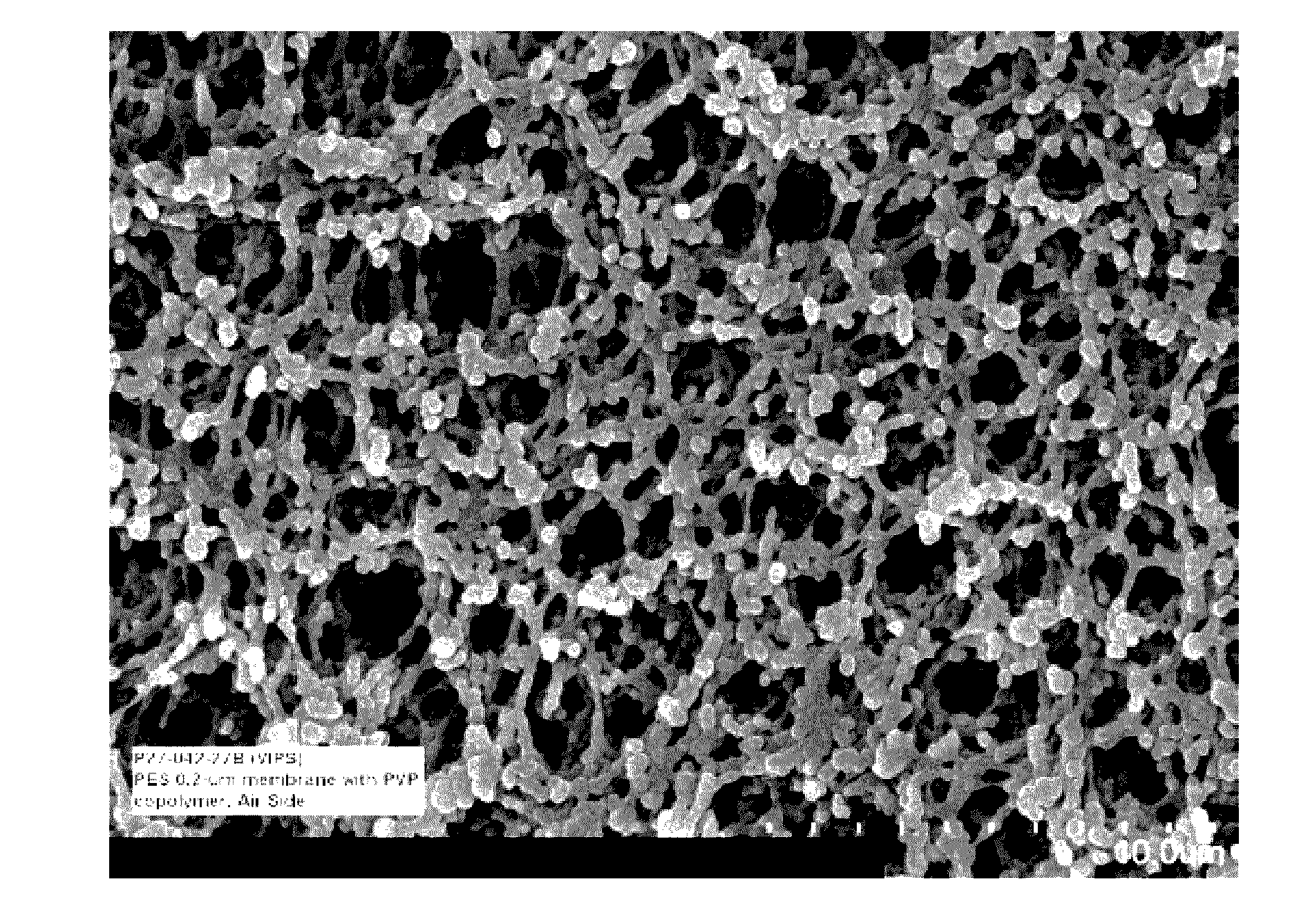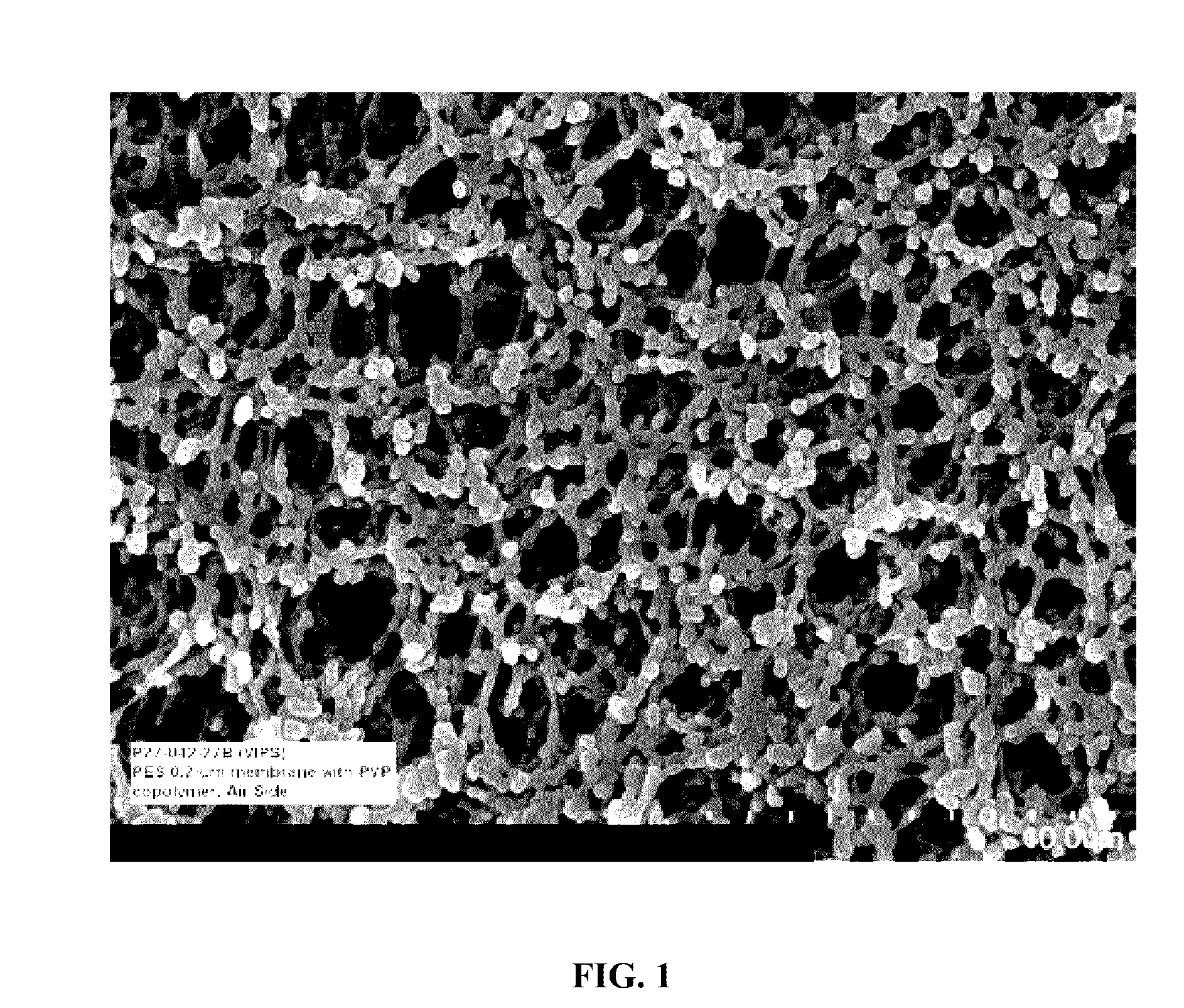Self-wetting porous membranes (i)
a porous membrane and self-wetting technology, which is applied in the field of self-wetting porous membranes (i), can solve the problems of limiting the usefulness of the membrane, the porous membrane made of these polymers is not wettable by water, etc., and achieves high critical wetting surface tension (cwst), high water wettability, and high degree of compatibility
- Summary
- Abstract
- Description
- Claims
- Application Information
AI Technical Summary
Benefits of technology
Problems solved by technology
Method used
Image
Examples
example 1
[0051]This example illustrates a method of preparing a macro-CTA (Chain Transfer Agent) in accordance with an embodiment of the invention.
[0052]The starting diamino-macromer (24.0 g; 8 mmol of NH2) and sodium mercaptoacetate (2.74 g; 24 mmol) were dissolved in anhydrous DMF (160 mL) followed by dropwise addition of 50% DMF solution of T3P (15.3 g; 24 mmol) with vigorous stirring at ambient temperature. After 24 h the reaction mixture was quenched by pouring into 1.4L of vigorously stirred water. The precipitate formed was filtered-off, washed with water (2 times 500 mL), acetone (500 mL), and diethyl ether (200 mL). The obtained solid was further purified by re-precipitation by dissolving in chloroform (300 mL) and adding dropwise into stirred methanol (1.5L). The precipitate was collected by filtration, washed with copious amount of methanol and dried in vacuum oven at 60° C. overnight, yielding 22.3 g of product.
[0053]1H NMR analysis (in DMSO-d6) indicated the complete disappearan...
example 2
[0054]This example illustrates a general protocol of preparing copolymer A-B-A in accordance with an embodiment of the invention.
[0055]Macro-CTA was dissolved in anhydrous NMP, followed by addition of the vinyl monomer and AIBN as radical initiator. The resulting mixture was purged with argon at ambient temperature for at least 2-5 min, followed by the heating at 80° C. for 16-24 h. After that time the reaction mixture was open to air and added to excess of vigorously stirred non-solvent, usually at least 10 volumes of 2-propanol. The resulting precipitate was filtered-off (or centrifuged in some cases), rinsed well with 2-propanol and dried in vacuum oven at 70° C. overnight. The obtained material was analyzed by GPC (DMF with 0.05N LiBr, calibrated with PMMA molecular weight standards) and the composition was determined by the 1H NMR analysis and the elemental analysis.
example 3
[0056]This example illustrates a method of preparing PVP-b-PSU-b-PVP, with (m1+m2) / n=0.20, in accordance with an embodiment of the invention.
[0057]The macro-CTA (0.5 g; 0.165 mmol of SH), 1-vinylpyrrolid-2-one (1.1 mL; 9.9 mmol) and AIBN (3 mg; 0.018 mmol) were dissolved in anhydrous NMP (2 mL) and copolymerized according to the above protocol, yielding 0.49 g of the desired product.
[0058]1H NMR analysis (in CDCl3) indicated 20 molar % of VP unit, as determined by comparing integration of signals between 7.75-8.00 ppm (4H of PSU unit) and 3.00-4.00 ppm (3H of VP unit). Elemental analysis (% N=0.80; % S=7.12) gave 21 molar % of VP. GPC: Mw=19833; PDI=1.85.
PUM
| Property | Measurement | Unit |
|---|---|---|
| hydrophobic | aaaaa | aaaaa |
| hydrophilic | aaaaa | aaaaa |
| self-wetting | aaaaa | aaaaa |
Abstract
Description
Claims
Application Information
 Login to View More
Login to View More - R&D
- Intellectual Property
- Life Sciences
- Materials
- Tech Scout
- Unparalleled Data Quality
- Higher Quality Content
- 60% Fewer Hallucinations
Browse by: Latest US Patents, China's latest patents, Technical Efficacy Thesaurus, Application Domain, Technology Topic, Popular Technical Reports.
© 2025 PatSnap. All rights reserved.Legal|Privacy policy|Modern Slavery Act Transparency Statement|Sitemap|About US| Contact US: help@patsnap.com



